المدير العام
المدير العام


عدد المساهمات : 1713
السٌّمعَة : 1
تاريخ التسجيل : 26/08/2011
 | |  The Tomb of Ptah-Hotep & Akhti-Hotep مقبره بتاح حتب بسقاره The Tomb of Ptah-Hotep & Akhti-Hotep مقبره بتاح حتب بسقاره | |
|
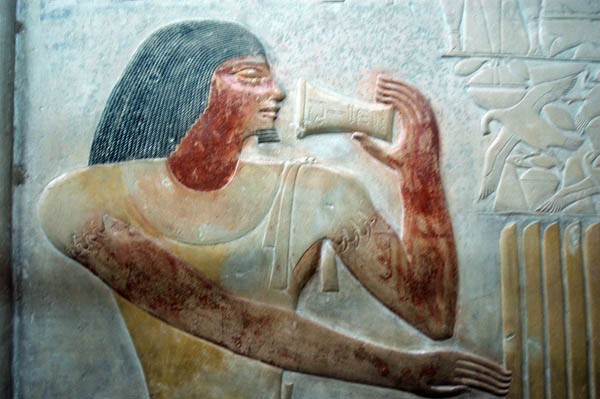
The Tomb of
Ptah-Hotep & Akhti-Hotep
The necropolis of Memphis, the Old
Kingdom’s capital, stretches 30km along the Nile including Abu-Rawash,
Giza, Zawyet el-‘Aryan, Abu Ghurab, Abusir, Dahshur and Saqqara (Daoud,
2006, p.2). Saqqara is 6km long and has extensive individual’s
cemeteries and was used from the pre-dynastic period and for the
following 3,000 years.
Mariette
recorded D.64 in the 1850s at Saqqara, which was further recorded
between the 1860’s and 1900’s. It is located 300m north-west of the Step
Pyramid (Figure-1). It has a standard mastaba design measuring 80½’ by
63’ with an inward 1:20 slope and was constructed of limestone blocks
faced with fine Tura limestone (Quibell, 1898, p.25).
The sepulcher contained Ptah-Hotep II and his son
Akhti-Hotep. The name Ptah-Hotep was “fairly common” and used by other individuals buried at Saqqara, Davies (1901,
Part-2, p.21), hence the suffix of II.
[size=19]
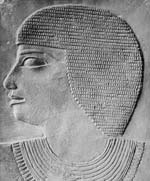 The tomb (Figure-2) is dated to The tomb (Figure-2) is dated to
the end of the 5th-Dynasty using inscriptions on the East and South walls of Ptah-Hotep’s chapel and also
from the west wall of Akhti-Hotep’s chapel. Inscriptions report that they both held the title Chief Priest of the
Pyramid cities of Ny-user-Re (c.2445-2421 BC), Men-Kau-Hor (c.2421-2414 BC) and Djed-Ka-Re Isesi (c. 2414-2375
BC). This dates (Shaw, 2002, p.480) the tomb to 39-years between 2414-2375 BC (it is possible the title relates to
Isesi’s mortuary-cult). There is no indication of how long the tomb took to build but two of the
builders are known from inscriptions:[/size]
East/West walls 17’5”
North/South walls 7’2”
Ceiling 12’5” high - lower 3’ limestone, upper
9’5” Tura limestone
4402 feet of carved reliefs
 East/South walls have upward sloping ceiling level holes linking to East/South walls have upward sloping ceiling level holes linking to
the Mastaba roof – their position would illuminate the false-doors. There may have been religious purpose, such as a
route for the Ba to access
the terrestrial world.
The carved area of the focal west wall is
constructed from two massive limestone slabs. Other walls are made using small poorer quality slabs. The ceiling is
formed by two limestone slabs grooved to represent traverse palm logs, which were painted dark-red.
Presentation of Information, Techniques and Colours
The southern false-door of Ptah-Hotep is an example of the efforts that
craftsmen applied to construct the “house of life”. The door protrudes 8” into the chapel and was created by carving
into the surface of a slab (8’ by 9’) until the door was formed.
Reliefs are based on an isolating composition where separate, although
physically contiguous, vinaigrettes are largely independent of another (Wolff, 1972, p.69). Wall scenes were divided
into a number of horizontally stacked registers, ‘grounded’ by a distinct baseline which all figure are firmly placed.
Robins (1990, p.18) explained that registers are neutral in relation to space and time and didn’t intend to indicate
relationships between the different scenes or to imply depth by being physically higher than another. The scenes are
often loosely related by theme and scenes may be repeated.
Pictorial and symbolic colour was a critical to the convention of scenes
(Davies, 2001, p.XIII);
artists who were able to apply artistic flexibility and dexterity used a small range of polychrome colours
(red/yellow/blue/green/black/white) and Robins (1990, p.23) writes they were “derived from mineral pigments” which
explains how they have remained bright and vibrant. Some blending of colours was used, e.g. the background of
Ptah-Hotep’s chapel is dull grey. Strongly symbolic colours were within a convention (Wolff, 1972, p.69);
vegetation/green, water/blue, males/reddish-brown, noble-women/white. Davies (2005, p.XV)
stresses that the scenes were “designed to be seen and admired” as well has being achieving their spiritual objectives.
Griffith inspected Ptah-Hotep’s chapel in 1898 (Quibell, p.25) and he
reported sadly that when the mastaba was first discovered the walls “were still exquisitely coloured” and the taking of
“casts and wet squeezes has irretrievably robbed us of half the beauty and interests of the tomb”. Only the false-doors
retained their colour because they are painted and not in relief carving.
Figure-3 demonstrates the intensity as it might have originally appeared and
combined with the deep-red roof to construct a powerful and polarized message.
Canon of Proportion
Egyptians reproduced the third-dimension on a flat surface within a ‘rule’
or ‘Canon of Proportion’ and Iversen (1955, p.15) wrote that the height and width have “a definite geometrical relation
to one another” (Figure-4).
David (1998, p.82) remarks that proportions of the human body are constantly
in relation to each other and, as Iversen added, the “standardization of these natural proportions was used as … the
system of linear measurement throughout Egypt”. The small cubit (0.45m) was the measure used in everyday purposes and
Iversen (1955, p.20) records this as “the length of the forearm from the elbow to the tip of the thumb outstretched”.
For standing figures; a grid of 18 equal parts, from the base-line to
hair-line, was used into which the parts of the human form were added (four-times the small cubit). Robins (1994, p.36)
adds that the critical lines corresponded to grids 6-9-12-15-18 and correlate to the knee-buttock-elbow-armpit-hairline
- Schäfer (2002, p.333) agrees saying that “Not only are the … lines of the helping framework always in the same
proportions” they “always intersect with the body at the same points”.
By adjusting the size of a grid to ‘fit’ the available space it was possible
to consistently reproduce an image of a person (Robins extends this to sitting figures which used a grid of 14 equal
parts).
The 18-grid is primarily used to create representations of the tomb owner;
Iversen (1955, p.31) stresses that it was “considered essential that they should conform in detail with the canon”.

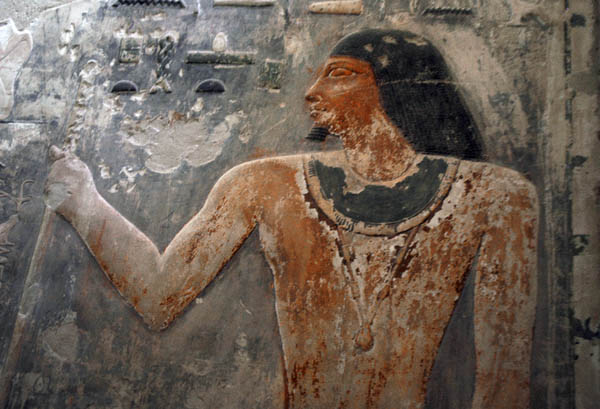
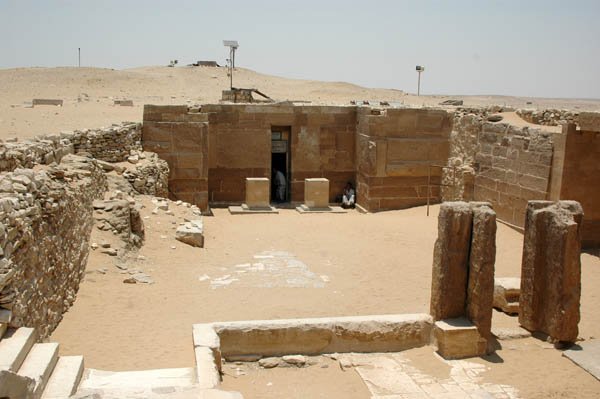

Conventions for the Human formTomb scenes were carefully designed to show not what people saw perceptually
but what they conceptually believed to be true – this image was then brought to life magically for eternity (David,
1975, p.67). Scenes “adhered to certain preconceived artistic forms and rules – so much so that ‘Egyptian’ has been used
to characterize any highly stylized, iconic art”, Arnold (1999, p.13). Each part of the human body was presented its most informative aspect.
David, Arnold and Robins agree that the head, arms, legs and feet are presented in profile; one-eye and eye-brow, navel,
shoulders and hands are shown from the front. Although physically impossible the image does present an image that is
understandable. Arnold (1999, p.14) also adds that the torso “appeared in a combination of frontal and profile views in
order to effect a transition between the other views”. The convention used to depict the tomb owner can differ from that used for
other individuals. The re-creation of physical activities doesn’t extend to the deceased who is usually shown in a
“passive role, watching rather than doing”, Malek (2002, p.129) and is often looking towards the tomb’s entrance. David
(1975, p.68) explains that a son may be encoded by the side-lock of youth and is typically depicted significantly
smaller than his father. From the titles associated with Ptah-Hotep’s children they must have been adults when the tomb
was decorated. David emphasizes that the size of figures indicates status and not perspective. In any scene the largest
figure is the most important (Figure-5). The tomb owner and other important figures were “rendered as young, vigorous
and beautiful”, Arnold (1999, p.11) while other less important figures are shown more honestly but still within
established conventions.
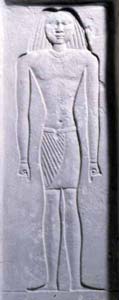 Schäfer (2002, p.299) captures the Schäfer (2002, p.299) captures the
essence saying “figures should never be judged as human forms comprehended in one glance. Such a view does not do
justice to the artist’s intention” which are “exemplifications of the ‘vision’”.Hands and FeetRepresentations of hands and feet can seem
confused.
 The convention for feet was that the same The convention for feet was that the same
foot attached to both left and right legs and was the hieroglyph rd for ‘foot’ (Robins, 1990, p.14); for left
facing figures it is the right foot and for right facing figure the left (the rear leg is always extended). Schäfer
(2002, p.295) wrote that the arch of the foot is recorded although it could only be seen on the inside of one foot and
“both arches cannot be seen at once”. Rare representations (see author’s image of Redine’s false-door) deviate from this
standard and can be less than visually successful.  Flexibility was Flexibility was
required for hands, based on the hieroglyph drt for ‘hand’, represented open-handed from the back (showing
the nails) or clenched from either the back or front (Robins, 1990, p.14).
 Scenes with a Scenes with a
staff/sceptre needed flexibility to maintain the structure of the image and simultaneously support the convention that
the staff was held in the rear hand and that the near hand held the sceptre. The two rightmost images from Ptah-Hotep’s
false-door demonstrate the creativity required to preserve the message; the sceptre/arm disappear behind the torso and
hands are presented in physically impossible positions. This blend of canonical form and practical solution presents a
clear and repeatable concept; Schäfer (2002, p.299) summarizes that the “representation of the hand … does not seem
arbitrary, but appears to be determined by a custom that varies with the spirit of the age”. Secular ScenesMany of the tomb scenes/inscriptions are secular in nature but continue to
enforce conceptual purpose. Some of these are:Fishing (nets, small boat & line)Industry (jewellery, boat building, wine, dried
fish)River scenes (jousting, cattle crossing, fowling
with nets)Children’s gamesDessert (hunting, wild animals in cages, animal
copulation)Crocodile - “O filthy one, may your heart be
pleased with water-weeds”False-Door and the Offering TableThe origin of the false-door is unclear but satisfies distinct functions; a spiritual
passageway for the Ka to transition between the worlds of the dead and living and a focal-point for offerings.
The false-door was still the sepulcher’s focal point during the late 5t-Dynasty,
Aldred (2004, p.85), and had reached the stage of development where significant inscriptions of the owner’s name and
titles were included within elaborate panel scenes (Figure-6). Wiebach-Koepke (2001, p.498) says the false-door,
possibly originating with the Helwan slab stela in the archaic period, was attested through-out the Old Kingdom reaching
it’s full canonical form during the 4th-Dynasty and Ikram (2003, p.161) lists the significant elements
as the cornice, upper-lintel, offering-stela, lower-lintel, roll, door, inner and usually an outer-jamb.
Wiebach-Koepke also explains that the false-door modelled the door of a contemporary Egyptian
house and during the late 5th-Dynasty was always located on the western wall of the offering-room and some
chambers can have many doors. Ptah-Hotep’s chapel has two doors, both on the western wall. The southern false-door follows a ‘conventional style’ defined by
Wiebach-Koepke (2001, p.499) and is surmounted with a corvette cornice and flanked by a torus molding. It is decorated
on all of the available surfaces with symmetric representations of Ptah-Hotep, a standardized inscription of his ideal
biography and the central focus of a small stela with an offering scene. Wiebach-Koepke (2001, p.501) wrote that Osiris
is mentioned in offering text from “second half of the 5th-Dynasty”. Ptah-Hotep is praised before the god a
number of times with phases such as “deserving before Osiris"; Quibell (1898, p.32) wrote that the false-door has
the invocation "may the King give an offering and may Osiris give an offering … that he [Ptah-Hotep] may have funerary
meals every day”. Quibell’s plan shows a ‘yellow stone’
htp  offering-table (Gardiner (2001, offering-table (Gardiner (2001,
p.501) loaf on a reed-mat) adjacent and freestanding in front of the false-door and as Bolshakov
(2001, p.573/4) explained “making it convenient for the tomb owner, who was meant to face out towards the opening of the
tomb” or “going forth”. This ‘alter’ was used to present physical offerings, converted into ka-doubles of the food, and
binding wall-scenes and daily invocations into a heterogeneous request for the gods to provide for Ptah-Hotep’s eternal
well-being. Quibell (1898, p.31/2) described the un-inscribed northern false-door was painted and grained
to represent narrow wooden planks, which turned on black-painted pivots, with vertical spaces filled with woven mats
brightly decorated with coloured checks and chevrons (held down by cords passed through loops). Quibell also proposed
that because servants advance towards Ptah-Hotep from the north the door may symbolically lead into the offering-scene
from the house’s kitchens/storehouses. Both false-doors demonstrate a significant use of colour and
architectural features such as wooden panels, papyrus, palm-fond, pivots and woven material are translated into
“decoration long after they ceased to have any structural meaning”, Flinders-Petrie (1999, p.45) and that the “chequer
patterns is unmistakably in plaiting and weaving”. Between the false-doors is the offering-scene, an epitome of the southern false-door’s Stela,
and as the central element of the chapel is the most critical in enabling Ptah-Hotep an eternal life. It is divided into
four significant parts: [1] Many titles are listed including (Quibell, 1898, p.33/4): Governor of the pyramid city, enlightener of
the priests of the pyramid 'Nefer' of Djed-Ka-Re Isesi and of the wab priests of the pyramid 'Men-Sut’ of
Ny-user-Re and of the priests of the pyramid 'Neter-Sut' of Men-Kau-Hor Next after the KingStaff of the enlightened peopleTraverser of desertsCaptain of the royal boatInspector of canals, southern throneGovernor of the Great HouseDirector of the Great Court (Judge)Director of artists and scribesChief of the king’s secretsWorthy before the great god Osiris and Anubis
chief of the Western DeadCaptain of great ones of the Southern TensPriest of Ma’at and Hekt (frog goddess) [2] Ptah-Hotep is sitting with a unguent vase held to his nose,
before an offering-table loaded with bread, offerings of thousands of bread/beer/beef/fowl/linen/alabaster/deer and
surrounded with plentiful things. [3] Registers depict [from top] priests offering and reciting
prayers followed by registers of important officials making offerings. [4] Extensive list of daily offerings
recorded within a grid of 24-by-4 cells. Leprohon (2001, p.571) writes that it’s origin is the “royal
offering lists found in the Pyramid Texts” and was intended to be recited with the reading magically bringing the items
into being. Offering were recorded within cells followed by a number, for example one Malachite and four Loaves.
Leprohon explains that some items are food and some are more cultic such as incense or water libation (being used in the
upper register [3]). Serdab & Statues
 Akhti-Hotep has a Serdab or walled-up enclosed Akhti-Hotep has a Serdab or walled-up enclosed
chamber located off-of his chapel’s southern wall. D’Auria/Lacovara/Roehrig (2000, p.88) wrote that the ancient
term was pr twt (Statue Chamber).
The Serdab would have held one or more statues of Akhti-Hotep and possibly other family members. The Ka was believed to
be able to live within a statue (Kanawati, 2001, p.59), which was protected within the
inaccessible room, and this was a way of allowing the Ka to exist even if the physical body decayed or was destroyed. No statues were found in the tomb and it’s possible that it was robbed or,
more likely, a wooden statue was used which has since been eaten by white-ants. Aldred (2004, p.98) explained that
wooden statues were covered in gesso, which was painted, and had realistic artificial eyes and were often standing
adopting a striding pose (Figure-7 is an example of a statue dating to the same period) with the left foot thrust
forward. ConclusionThe tomb scenes, especially those on the west wall, are carefully designed
to employ magic to grant Ptah-Hotep an eternal-life and to provide him, and others, with permanent environment and
equipment for the endless repetition of the services being displayed.
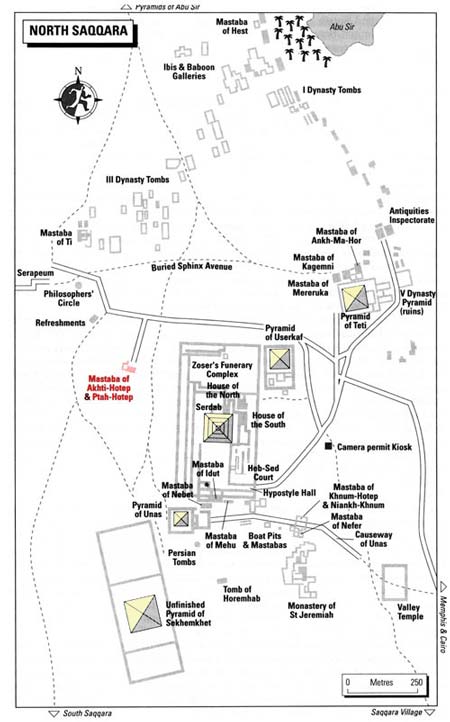 Figure-1 Figure-1
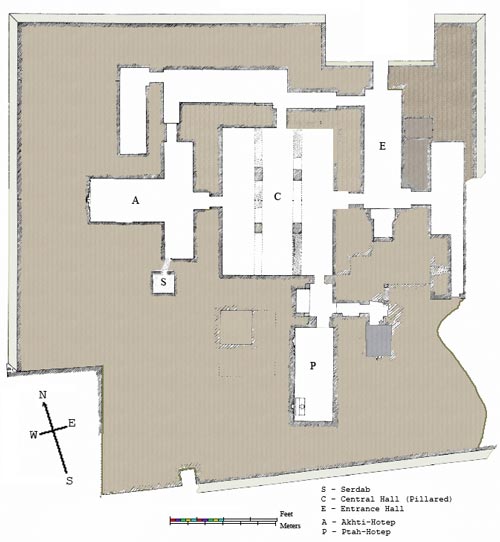 Figure-2 Figure-2
 Figure-3 Figure-3
 Figure-4 Figure-4
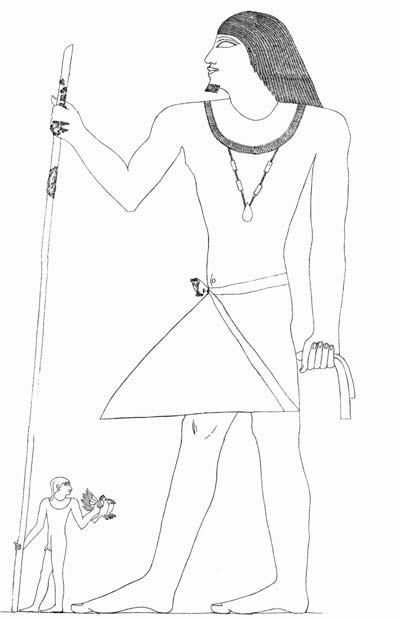 Figure-5 Figure-5
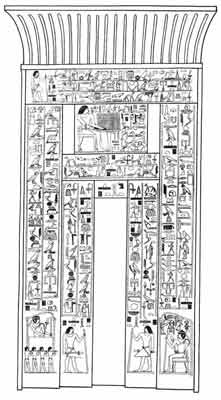 Figure-6 Figure-6
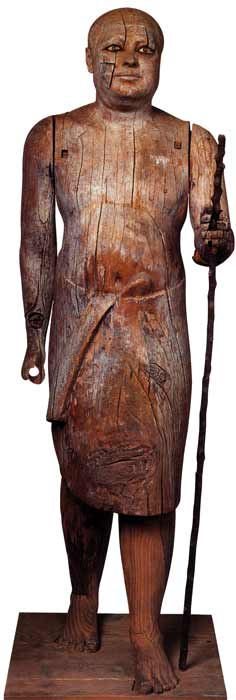
Figure-7, located in the Egyptian
Museum Cairo. From the Saqqara tomb C8 of Ka-Aper (commonly known as Sheikh el-Beled) and dating to the beginning of the
5th-Dynasty.
Bibliography – Primary & sources referenced within document
Aldred, Cyril
| 2004
| Egyptian Art
| Thames & Hudson (London)
| Arnold, Dorothea
| 1999
| When the Pyramids were Built, Egyptian Art
of the Old Kingdom
| Rizzoli International Publications (New York)
| Bolshakov, Andrey
| 2001
| Offering-Table - The Oxford
Encyclopaedia of Ancient Egypt, Volumes 1 in Redford, Donald (Ed)
| Oxford University Press (Oxford)
| D’Auria, Lacovara, Roehrig
| 2000
| The Funerary Arts of Ancient Egypt
| Museum of Fine Arts (Boston)
| Daoud, Khaled Abdalla
| 2005
| Corpus of Inscriptions of the
Herakleopolitan Period from the Memphite Necropolis
| Archæopress (Oxford)
| David, A. Rosalie
| 1975
| The Egyptian Kingdoms
| Elsevier International Projects Ltd (Oxford)
| David, Rosalie
| 1998
| The Ancient Egyptians
| Sussex Academic Press (Brighton)
| David, Rosalie
| 2002
| Religion and Magic in Ancient Egypt
| Penguin Books Ltd (London)
| Davies, N De G
| 1900
1901
| Mastaba of Ptahhetep and Akhethetep at
Saqqara,
Part 1 (1900) & Part 2 (1901)
| Egyptian Exploration Fund (London)
| Davies, W V (Ed)
| 2001
| Colour and Painting in Ancient Egypt
| British Museum (London)
| Flinders-Petrie, W M
| 1999
| Egyptian Decorative Art
| Dover Publications (New York)
| Freed, Berman, Doxey
| 2003
| Arts of Ancient Egypt
| MFA Publications (Boston)
| Gardner, Sir Alan
| 2001
| Egyptian Grammar
| Griffith Institute (Oxford)
| Iversen, Erik
| 1955
| Canons and Proportions in Egyptian Art
| Sidgwick & Jackson (London)
| James, T G H
| 1985
| Egyptian Painting
| British Museum (London)
| Kanawati, Naguib
| 2001
| The Tomb and Beyond, Burial Customs of
Egyptian Officials
| [size=119]Aris & Phillips, Warminster
| Kemp, Barry
| 2006
| Ancient Egypt; Anatomy of a Civilization (2nd
Edition)
| Routledge (Abingdon, Oxon)
| Leprohon, Ronald
| 2001
| Offering-List
- The Oxford Encyclopaedia of Ancient Egypt, Volumes 1 in Redford, Donald (Ed)
| Oxford University Press (Oxford)
| LeWitt, Sol
| 1967
| Paragraphs on Conceptual Art
| Artforum
| Lively, Penelope
| 1987
| Moon Tiger
| Penguin Books (London)
| Malek, Jaromir
| 2002
| Egyptian Art
| Phaidon Press (London)
| Panofsky, Erwin
| 1997
| Perspective as Symbolic Form
| Zone Books (New York)
| Perrot, Chipiez (translated by Armstrong, Sir
Walter)
| 1883
| A History of Art in Ancient Egypt, in two
volumes
| Chapman and Hall (London)
| Quibell, J. E.
| 1898
| The Ramesseum and the Tomb of Ptah-Hetep
|
| Richardson, Dan
| 2001
| The Rough Guide to Egypt
| Rough Guides (London)
| Robins, Gay
| 1990
| Egyptian Painting and Relief
| Shire Publications (Haverfordwest)
| Robins, Gay
| 1994
| Proportion and Style in Ancient Egyptian Art
| Thames and Hudson (London)
| Sampsell, Bonnie
| 2003
| Traveler’s Guide to the Geology of Egypt
| American University in Cairo (New York)
| Schäfer, Heinrich
| 2002
| Principles of Egyptian Art
| Griffith Institute (Oxford)
| Shaw, Ian (Ed)
| 2002
| The Oxford History of Ancient Egypt
| Oxford University Press (Oxford)
| Tiradritti, Francesco (Ed)
| 1999
| The Oxford History of Ancient Egypt
| Harry N Abrams, Inc (New York)
| van Walsem, René
| 2005
| Iconography of Old Kingdom Elite Tombs,
Analysis & Interpretation, Theoretical and Methodological Aspects
| Ex Oriente Lux (Leiden)
| Wiebach-Koepke, Silvia
| 2001
| False-Door - The Oxford
Encyclopaedia of Ancient Egypt, Volume 1 in Redford, Donald (Ed)
| Oxford University Press (Oxford)
| Wolff, Walther
| 1989
| The Origins of Western Art
| Universe Books (New York)
|
Bibliography – Secondary sources
Freed, Berman, Doxey
| 2003
| Arts of Ancient Egypt
| MFA Publications (Boston)
| Holly, Michael Ann
| 1985
| Panofsky and the Foundations of Art History
| Cornell University Press (Ithaca & London)
| James, T G H
| 1985
| Egyptian Painting
| British Museum (London)
| Kelly Simpson, William
| 1980
| Mastaba of the Western Cemetery, Part 1
| Museum of Fine Arts (Boston)
| Markowitz, Haynes, Freed
| 2002
| Egypt in the Age of the Pyramids
| Museum of Fine Arts (Boston)
| Michalowski, Kazimierz
| 1969
| Art of Ancient Egypt
| Harry Abrams Inc (New York)
| Reisner, George Andrew
| 1942
| A History of the Giza Necropolis, Volume 1
| Oxford University Press
(Oxford)
| Robins, Gay
| 2000
| The Art of Ancient Egypt
| Harvard University Press (Cambridge,
Massachusetts)
|
[/size][/size] |
| |
|
